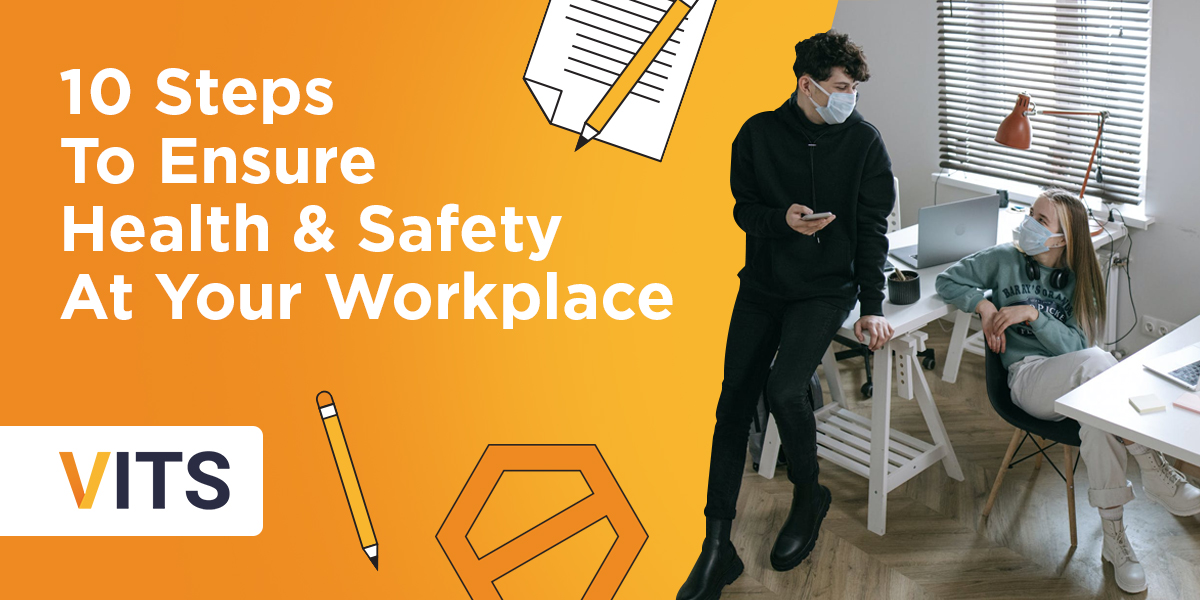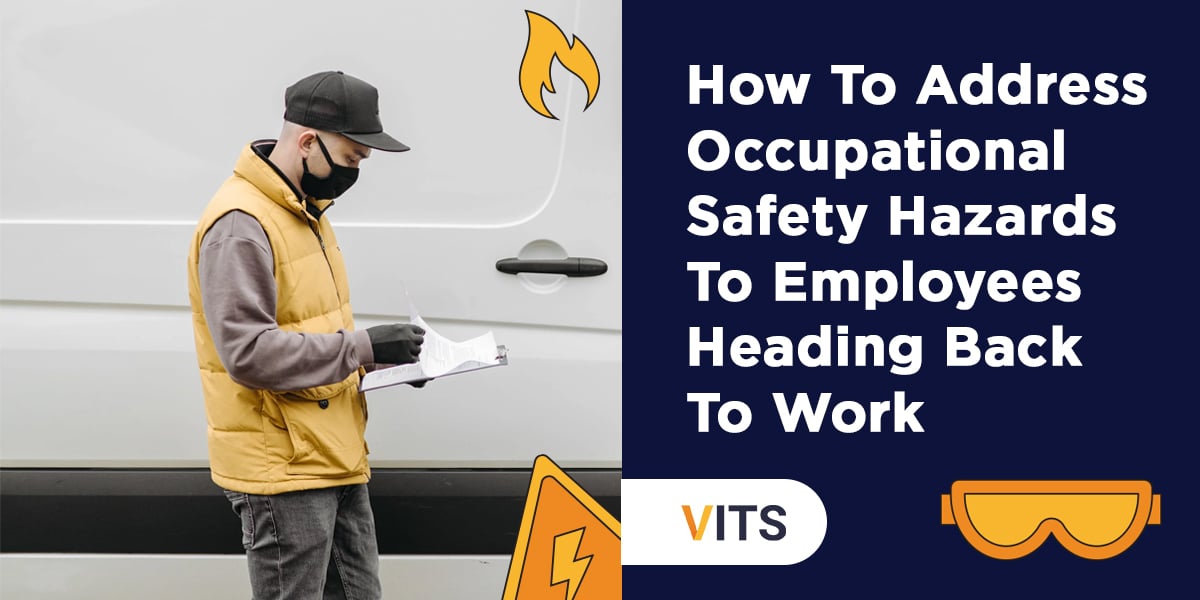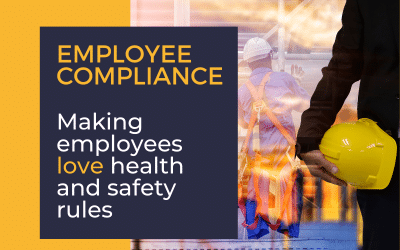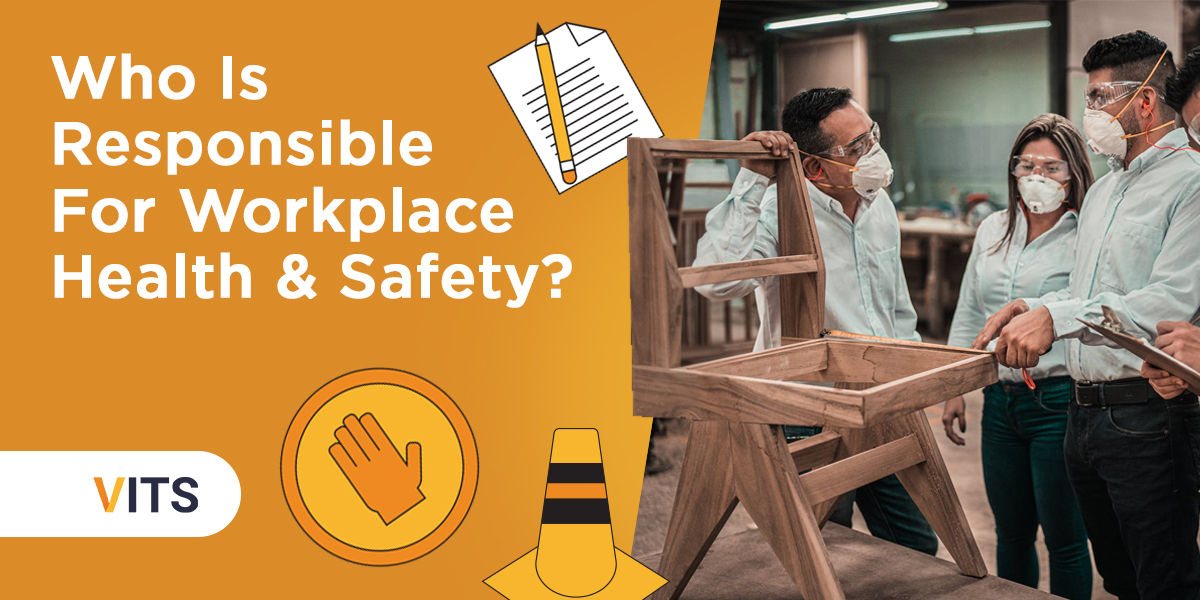10 Steps to Ensure Health and Safety at Your Workplace
In 2015, injuries and illnesses cost $60 billion in lost productivity, and the top 10 injuries cost $51.4 billion of that.
And at the top of the list? Overexertion.
The most serious risks are due to overexertion, which causes 24% of injuries making up nearly a quarter of all injuries. Next on the list is falls on a similar scale, which causes 19%. Falls cost employers up to $11.2 billion a year in medical expenses, worker’s compensation, legal costs and property damage.
The costs of workers compensation insurance – and the potential harm to your business – can be high.
The good news is, that employers can involve their employees in the planning and implementation of health programs, for a better employee experience.
Top 10 Hazards in the Workplace.
Here is a list of hazards present in nearly every workplace around the globe:
- Overexertion
- Hazardous Chemicals
- Falls
- Scaffolding Hazards
- Systems that cause electrocution and potential fires
- Falling Objects
- Malfunction of machinery or equipment
- Vehicle Accidents
- Objects in the workplace that can obstruct movement (including wiring)
- Respiratory Hazards
Health and Safety: What is it?
Every employer must take responsibility for the health and safety of employees in the workplace. They should set protocols to ensure compliance with standards. Employees have the right to feel safe at work. Which means they should feel free to execute their duties and tasks without fear of their health and safety being threatened.
Define Health and Safety.
Every employee is entitled to carry out his daily work without having to worry about his safety. There are laws that must be followed to provide this environment, and it is the responsibility of employers to facilitate these laws.
What is Health and Safety in the Workplace?
The law puts an obligation on employers to provide a safe place of work for workers. This means they have to take steps to keep workers safe. The employer manages risks to employees' health and safety by preventing them from happening in the first place or by controlling them before they start. General health and safety in the workplace starts with proper implementation of a health and safety program and effectively protects your employees from work related health and safety risks.
How Do You Encourage Your Employees to Work Safely?
When you think about it, what strategies do you use to make it clear to your employees how important safe habits are? If you want your employees to be safe and happy at work, you need to model and encourage safety and happiness.
Create a Workplace Safety Culture.
If you want to reduce workplace injuries, you can minimize them by improving the safety consciousness of your employees. Your workers' compensation costs can skyrocket if you don't take proactive steps to keep your workplace safe. You must first identify the root causes of workplace injuries and watch out for potential safety hazards in equipment and work design.
The best way to understand how to prevent workplace injuries is to get the advice of an occupational health expert.
To create a company culture where safety is always top of mind, you should first look at your major workplace safety “hot spots”. Once you understand your existing safety hazards, you can begin building a safety culture and enlisting employees in that effort.
10 Health and Safety Tips.
Take a look at these workplace safety tips to help create a safer workplace.
- Train Effectively
A comprehensive safety training program is vital to preventing workplace injuries. No matter how experienced your employees are, ensure that they have all the requisite training for their positions. See to it that your employees are properly trained, especially when it comes to safety. When the proper safety training is not in place, workplace injuries can happen.
- Reward over Risk
You can increase your employees' engagement with safety policies by giving out small rewards to those who follow them. Rewarding employees who follow safety policies may help keep them engaged, which in turn reduces workplace accidents.
- Consider Hiring a Specialist
When you hire an occupational health and safety specialist, you can get valuable insight into workplace injury and prevention. If you're worried about employee injuries, it's worth checking in with these specialists, who can help you navigate your work site and suggest ways to make it safer. These professionals will find out just how likely it is that your employees will get injured on the job and ensure that, if there is a risk, you have the means to avoid it.
- Leverage Labels & Visual Communications
Labels and signs are simple tools that everyone can understand. They’re often used in dangerous or confusing situations to remind even the most experienced employees how to act. Labels are often used to direct workers to different areas, notify them of equipment details, and in some cases prevent injury. By labeling your hazardous chemicals or posting safety signs, you can direct staff towards safer behaviors.
- Keep it Tidy, Keep it Clean
A messy workspace can be a safety hazard. Just like with other workplace safety issues, it's important to identify which hazards are present, what you can do about them, and whether they represent an actual threat to your employees. But how can you identify hazards if your workplace is cluttered and littered with tools, cords, and other paraphernalia? When your workplace is cluttered, you might miss important signs of danger.
- Ensure Employees are Equipped
Make sure you have the right tools and equipment on hand, and that you service and inspect them regularly.
If workers don't have the right tools or equipment, they will be unable to perform their jobs properly. They may also be injured by malfunctioning equipment.
- Encourage Ergonomics
Taking breaks to stretch or walk is an effective way to ease muscle tension and loosen joints. A simple break performed by walking around the office for 5 minutes can help to reduce claims.
- Safety Starts at the Beginning
Employee safety starts with all staff members working safely and following the policies and procedures for each job role, from day one. It could also help to include the implementation of a physical assessment prior to hiring new employees.
- Encourage Communication Channels
Your employees know their jobs and work areas best. They can identify potential hazards that others might overlook. Make it safe and easy for them to share health and safety concerns by appointing or nominating a safety captain to receive and review reports.
- Frequent Meetings
Everyone’s safety is an important part of company goals. Therefore, you can never be too prepared when it comes to safety. Regular meetings should be held, with safety rules reviewed and all employees should participate in developing safety plans and discuss ways to prevent injuries from occurring.
Workplace health and safety should also be specialized according to the type of work and industry. Take a look at these extra, specialized tips for specific industries:
Quick Tips: Office Health and Safety Tips
Construction sites are not the only place where workers face hazards. Do soft office chairs and climate controlled rooms conjure up images of a dangerous workplace? Of course not - but there are several health risks lurking behind the comfort of an air conditioner (and other office commonalities).
Eyesight
- Most people don't want to think about the dangers a computer screen poses to our eyes. If you or your employees spend hours in front of a screen then it is essential you not only understand the risks involved, but take preventative steps to safeguard eyesight.
- Following the 20/20 rule can help to exercise your eyes. An optometrist will advise you to spend 20 minutes looking at the screen, and then 20 seconds staring 20 feet in front of you.
- A proactive step is to ensure the computer screens are not up against a wall so that employees avoid using only their short sight.
- And another tip: Blue light is not just a trend. It is essential to safeguard the eyes from the harmful effects of blue light. While you don’t necessarily have to provide every desk employee with blue-light glasses, educating them about the dangers of blue light will at least empower them to decide whether or not they want to use blue light glasses or not.
- Posture is extremely important and cannot be emphasized enough. Consistent reminders about ergonomic working postures can help to educate employees as well as remind them to maintain a safe posture that won't cause injury (and claims) further down the line. Remind employees to maintain a neutral position that does not strain their wrists or neck.
- To avoid health risks, it's important to take regular breaks. Stand up for a few minutes at regular intervals to increase circulation.
Cleanliness
- A clean workspace is a healthy workspace. Keep office supplies and tools organized. Don't let clutter pile up anywhere. Don’t use electrical cords in a way that poses a risk of fire and avoid running them under carpets or in a way that would pose a trip hazard.
- Ensure there are proper procedures in place in the event of emergencies and that your employees are familiar with what to do in a variety of emergency situations, especially fires.
Quick Tips: Healthcare Worker Safety Tips
There are several serious safety hazards afflicting medical staff on the job. Workplace infections and other serious incidents are common amongst medical workers. Their jobs expose them to a variety of health risks, which include workplace assault, accidental needle incidents, latex exposure, pathogens, exposure to harmful chemicals, exposure to radioactive materials, and not to mention the high stress levels.
Ensure Staff are Trained to Avoid Bloodborne Pathogen Exposure
Health care staff are often in contact with the bodily fluids and blood of patients and that renders them susceptible to exposure to and spread of bloodborne pathogens. Bacteria and viruses are found in blood and other body fluids, and staff can get infections when someone else touches these fluids. To maximize safety and minimize the risk of infection, medical personnel should be outfitted with appropriate protective gear. That may include gowns, gloves, goggles, and face shields. It's important that the medical center/health care center manage risk, reduce the spread of infections, and destroy dangerous microbes.
Proactive Safety for Sharp Objects
Healthcare workers are often working with sharp tools, such as scalpels, needles and other medical devices. Sharps can pose a health hazard, and the danger is magnified with improper disposal. By putting sharps disposal containers readily available, employees are less likely to dispose of needles in inappropriate places. This safeguards against exposure to infectious diseases.
Safety guidelines can help contain the risk of cuts and injuries. When using sharp instruments, you need to take precautions, such as disposing of syringes immediately after use in separate safeboxes. It is also imperative that blunt needles are always used for suturing, along with scalpel blades with slightly rounded tips.
Ensure Proper Training for Handling Chemical Substances
Employee safety training must be provided due to the possible risk of exposure to hazardous chemicals during the hospital facilities' activities. Doctors are responsible for the provision of appropriate information that will help to limit the personnel's exposure to dangerous substances. When it comes to HAZMAT issues, gloves and other personal protective equipment are the only line of defense that works.
Health and Safety Guidelines in the Workplace
The Following Practices Should Help to Keep Your Workplace Safety & Health on Track.
- Ensure that work safety information is readily available for all employees, including staff members that have been ‘on the job’ for many years as well as new employees.
- Displaying health and safety messages in a workplace is a small but significant way to boost your workplace’s safety culture. Health and safety tips for employees can be displayed as visual signs and posters in the workplace or as a daily email reminder for office workers. You can incorporate weekly or even daily safety tips and toolbox talks to boost employee morale and to encourage all employees to build a safer workplace together.
- Health and safety instructions for specific jobs and tasks, especially if they are new tasks as often happens with construction sites, should be given out daily and especially prior to commencement of the hazardous task. It is a good idea for every worker to have a copy of these instructions and for every employee to have a clear comprehension of what is meant by health and safety.
- You have a responsibility to protect your employees and provide a safe workplace. These ten tips can help to kickstart your workplace safety and partnering with VITS can help make your workplace health and safety simple.
- Personal safety in the workplace should be emphasized. This is because a strong safety culture is built by all the employees- not just those that set out the rules and regulations. All employees need to understand that they play an active role in cultivating a safe workplace.
OSHA Health and Safety Guidelines
The following OSHA Guidelines are laid out for your awareness and for your convenience, we have also laid out how VITS software can help to abide by these guidelines.
Prevent Workplace Injuries and Illnesses
Safety is not just about avoiding accidents. It is about leadership, management responsibility, and worker involvement. All these elements need to be used to create a proactive approach towards preventing workplace injuries and illnesses.
Improve Compliance with Laws and Regulations
VITS assists with compliance with health and safety regulations. VITS provides a centralized, streamlined method for tracking events, incidents or hazards that affect worker health and safety. Our software helps improve safety compliance by alerting you of potential violations and streamlining your health and safety reporting process.
To ensure you remain compliant with ever-changing regulations, your company will benefit from a health and safety software solution that gives you the means to identify, record, report and analyze potential workplace hazards in real time. Knowing what's happening in the field when it happens will create an opportunity for your company to improve compliance with laws and regulations while minimizing injury, illness, property damage and lost time.
Reduce Costs, Including Significant Reductions in Workers' Compensation Premiums
Many businesses today are finding it increasingly difficult to control the costs associated with health and safety in their workplace. One way to reduce these costs is to put in place an effective health and safety management system (HSMS), including managing OH&S risks effectively through the introduction of VITS into the workplace.
Enhance Their Social Responsibility Goals
Our software is an easy to use, cloud based platform that helps businesses achieve their health and safety targets, by keeping track of checklists, managing audits and sending alerts for upcoming deadlines. Whether they are looking to meet legislative requirements or simply increase awareness our software will help them measure the impact of their health and safety activities.
Increase Productivity and Enhance Overall Business Operation
Our VITS software has been designed to allow your company to enhance your overall health and safety while increasing your workplace performance and productivity. The easily integrated software allows health and safety professionals to manage their workload more efficiently, contributing to a stronger safety culture in the workplace. H&S specialists or representatives are enabled to spend more time on the ground, instead of beating their way through a bureaucratic nightmare.
Discover how VITS can encourage a healthy safety culture while making it simple for specialists to implement an effective health and safety program by chatting with a VITS team member or simply booking a demo today.







